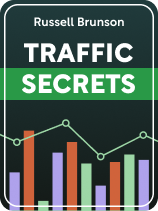

This article is an excerpt from the Shortform book guide to "Traffic Secrets" by Russell Brunson. Shortform has the world's best summaries and analyses of books you should be reading.
Like this article? Sign up for a free trial here.
Are you looking to boost your online business? Have you considered tapping into other people’s distribution channels?
In his book Traffic Secrets, Russell Brunson explains how to leverage existing networks to promote your products and services. He outlines methods such as buying ads, partnering with creators, and training affiliates—essentially building your own “affiliate army.”
Read more to discover how Russell Brunson’s affiliate marketing strategy can transform your online presence.
Russell Brunson on Affiliate Marketing
According to Russell Brunson, affiliate marketing allows you to tap into other people’s distribution channels. In every market, there are creators, publishers, and marketers who’ve built up their distribution channels—email lists, followers on social media sites like Facebook and LinkedIn, subscribers to podcasts, and so on. You can jump-start your business by engaging the leaders of those distribution channels to tell their followers about your product. In this way, those leaders become what Brunson calls your “affiliate army.”
(Shortform note: The effectiveness of an affiliate network does not solely rely on the size of the distribution channel, but also on the strength of the relationship between the affiliate and their audience. Successful affiliates have a deep connection to their audience and are positioned as part of the “in-group.” As Seth Godin explains in This Is Marketing, when such an affiliate recommends a product or a service, their followers, who want to identify with that person because they’re part of their group, will pay attention to that message far more readily than they will a message from someone outside the group. This is what makes word-of-mouth marketing so successful, which is essentially what Brunson’s affiliate program is aiming for.)
Buy Ads
The simplest way to take advantage of affiliate lists is to purchase ads that the creator sends to their followers. These ads can bring you fast results: Typically within 12 to 48 hours of the email, you’ll see increased traffic on your site. However, Brunson cautions that these ads typically have a short window of effectiveness and that your increased traffic will quickly die down. Thus, you should weigh the cost of such ads against the benefits of spending your marketing money elsewhere.
(Shortform note: The decision of whether to spend your marketing budget on short-term ads or on other avenues may depend on the stage of maturity of your company—as your business evolves, so should your spending. In the early stages, invest your budget in building awareness and acquiring customers, which may mean buying ads as Brunson describes. Once established, you should shift your focus—and finances—toward sustaining your existing customer base, so that you devote more attention to retaining customers than attracting them.)
Partner With Creators
Another way to tap into other distribution lists is to partner with those creators to promote your product, and then pay them a commission for the sales they make for you. There are advantages to this approach: First, it results in a more sincere and enthusiastic promotion of your product. Second, it takes the financial risk off you—instead of paying for ads and hoping they produce sales, you only pay for sales after they’re made.
(Shortform note: Partnering with other creators in this way is called influencer marketing, and it’s become a popular technique for brands looking to promote their products. Though there are many benefits to the practice, as Brunson notes, marketers should also be aware of some possible pitfalls. If you partner with someone who has a controversial background or who subsequently is engaged in scandals, you risk alienating customers if they then associate you with that person’s behavior. You also relinquish some control over how your product is presented, and if the influencer makes false claims about it or presents it in an offensive way, your brand reputation may suffer.)
Train Your Affiliates
You may need to create detailed training programs for your affiliates that show them how best to promote your product. This will address two potential problems:
- If your affiliate is successful and popular, they tend to be less willing to put effort into your product.
- If they’re newer to the industry, they’re typically willing to put in more effort, but they’re often less effective because of their lack of experience and contacts.
In either case, a training program that makes your sales process clear and easy will enable them to become more effective in positioning and selling your product.
(Shortform note: In Launch, Jeff Walker outlines a similar approach to making things easy for your affiliates. Though he doesn’t discuss specific training programs, he advises that you come up with well-tested, easy-to-use marketing messages so that your partners are guaranteed to send their subscribers something that will be valuable to them. Affiliates don’t want to bother their followers with low-quality promotions, and they won’t want to partner with you again if your campaign is in any way difficult to follow—either for them or for their followers.)

———End of Preview———
Like what you just read? Read the rest of the world's best book summary and analysis of Russell Brunson's "Traffic Secrets" at Shortform.
Here's what you'll find in our full Traffic Secrets summary:
- Tips to drive traffic to your online business
- How to find the right customers for your business
- The importance of social media for marketing






